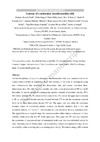Identificador persistente para citar o vincular este elemento:
https://accedacris.ulpgc.es/jspui/handle/10553/35716
| Título: | Anatomy of a subtropical intrathermocline eddy | Autores/as: | Barceló-Llull, Bàrbara Sangrá Inciarte, Pablo Pallás Sanz,Enric Barton, Eric D. Estrada-Allis, Sheila N. Martínez-Marrero, Antonio Aguiar González, Miguel Borja Grisolía, Diana Gordo, Carmen Rodríguez-Santana, Ángel Marrero-Díaz, Ángeles Arístegui, Javier |
Clasificación UNESCO: | 2510 Oceanografía | Palabras clave: | Intrathermocline eddy Mesoscale eddy Potential vorticity Canary Eddy Corridor |
Fecha de publicación: | 2017 | Publicación seriada: | Deep-Sea Research Part I: Oceanographic Research Papers | Resumen: | An interdisciplinary survey of a subtropical intrathermocline eddy was conducted within the Canary Eddy Corridor in September 2014. The anatomy of the eddy is investigated using near submesoscale fine resolution two-dimensional data and coarser resolution three-dimensional data. The eddy was four months old, with a vertical extension of 500 m and 46 km radius. It may be viewed as a propagating negative anomaly of potential vorticity (PV), 95\% below ambient PV. We observed two cores of low PV, one in the upper layers centered at 85 m, and another broader anomaly located between 175 m and the maximum sampled depth in the three-dimensional dataset (325 m). The upper core was where the maximum absolute values of normalized relative vorticity (or Rossby number), vertical bar ro vertical bar = 0.6, and azimuthal velocity, U=0.5 m s(-1), were reached and was defined as the eddy dynamical core. The typical biconvex isopleth shape for intrathermocline eddies induces a decrease of static stability, which causes the low PV of the upper core. The deeper low PV core was related to the occurrence of a pycnostad layer of subtropical mode water that was embedded within the eddy. The eddy core, of 30 km radius, was in near solid body rotation with period of similar to 4 days. It was encircled by a thin outer ring that was rotating more slowly. The kinetic energy (ICE) content exceeded that of available potential energy (ape), ke/ape = 1.58; this was associated with a low aspect ratio and a relatively intense rate of spin as indicated by the relatively high value of Ro. Inferred available heat and salt content anomalies were aha = 2.9 x 10(18) J and ASA = 14.3 x 10(10) kg, respectively. The eddy AHA and ASA contents per unit volume largely exceed those corresponding to Pacific Ocean intrathermocline eddies. This suggests that intrathermocline eddies may play a significant role in the zonal conduit of heat and salt along the Canary Eddy Corridor. | URI: | https://accedacris.ulpgc.es/handle/10553/35716 | ISSN: | 0967-0637 | DOI: | 10.1016/j.dsr.2017.03.012 | Fuente: | Deep-Sea Research Part I: Oceanographic Research Papers[ISSN 0967-0637],v. 124, p. 126-139 |
| Colección: | Artículos |
Citas SCOPUSTM
31
actualizado el 08-jun-2025
Citas de WEB OF SCIENCETM
Citations
30
actualizado el 08-jun-2025
Visitas
211
actualizado el 12-oct-2024
Descargas
2.356
actualizado el 12-oct-2024
Google ScholarTM
Verifica
Altmetric
Comparte
Exporta metadatos
Los elementos en ULPGC accedaCRIS están protegidos por derechos de autor con todos los derechos reservados, a menos que se indique lo contrario.
